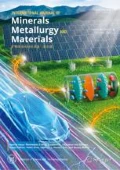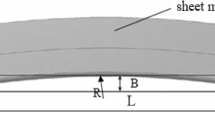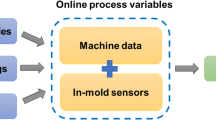Abstract
To deal with the increasing demand for low-volume customization of the mechanical properties of cold-rolled products, a two-way control method based on mechanical property prediction and process parameter optimization (PPO) has become an effective solution. Aiming at the multi-objective quality control problem of a company’s cold-rolled products, based on industrial production data, we proposed a process parameter design and optimization method that combined multi-objective quality prediction and PPO. This method used the multi-output support vector regression (MSVR) method to simultaneously predict multiple quality indices. The MSVR prediction model was used as the effect verification model of the PPO results. It performed multi-process parameter collaborative design and realized the optimization of production process parameters for customized multi-objective quality requirements. The experimental results showed that, compared with the traditional single-objective quality prediction model based on support vector regression (SVR), the multi-objective prediction model could better take into account the coupling effect between process parameters and quality index, the MSVR model prediction accuracy was higher than that of the SVR, and the optimized process parameters were more capable and reflected the influence of metallurgical mechanism on the quality index, which were more in line with actual production process requirements.
Similar content being viewed by others
References
S.Y. Xing, J.G. Ju, and J.S. Xing, Research on hot-rolling steel products quality control based on BP neural network inverse model, Neural Comput. Appl., 31(2019), No. 5, p. 1577.
S. Vaidya, P. Ambad, and S. Bhosle, Industry 4.0 — a glimpse, Procedia Manuf., 20(2018), p. 233.
Z.H. Deng, H.Q. Yin, X. Jiang, C. Zhang, G.F. Zhang, B. Xu, G.Q. Yang, T. Zhang, M. Wu, and X.H. Qu, Machine-learning-assisted prediction of the mechanical properties of Cu-Al alloy, Int. J. Miner. Metall. Mater., 27(2020), No. 3, p. 362.
S. Hore, S.K. Das, S. Banerjee, and S. Mukherjee, An adaptive neuro-fuzzy inference system-based modelling to predict mechanical properties of hot-rolled TRIP steel, Ironmaking Steelmaking, 44(2017), No. 9, p. 656.
X.Y. Sui and Z.M. Lv, Prediction of the mechanical properties of hot rolling products by using attribute reduction ELM, Int. J. Adv. Manuf. Technol., 85(2016), No. 5–8, p. 1395.
Y. Wang, D.W. Jiang, X.D. Wang, J.L. Zhang, Z.J. Liu, and B.J. Zhao, Prediction of blast furnace hot metal temperature based on support vector regression and extreme learning machine, Chin. J. Eng., 43(2021), No. 324(4), p. 569.
F.Y. Yan, Y.C. Chan, A. Saboo, J. Shah, G.B. Olson, and W. Chen, Data-driven prediction of mechanical properties in support of rapid certification of additively manufactured alloys, Comput. Model. Eng. Sci., 117(2018), No. 3, p. 343.
S.C. Worland, S. Steinschneider, W. Asquith, R. Knight, and M. Wieczorek, Prediction and inference of flow duration curves using multioutput neural networks, Water Resour. Res., 55(2019), No. 8, p. 6850.
P. Zhou, D.W. Guo, and T.Y. Chai, Data-driven predictive control of molten iron quality in blast furnace ironmaking using multi-output LS-SVR based inverse system identification, Neurocomputing, 308(2018), p. 101.
I. Charlier, D. Paindaveine, and J. Saracco, Multiple-output quantile regression through optimal quantization, Scand. J. Stat., 47(2020), No. 1, p. 250.
W. Deng, J.J. Xu, H.M. Zhao, and Y.J. Song, A novel gate resource allocation method using improved PSO-based QEA, IEEE Trans. Intell. Transp. Syst., 2020, No. 99, p. 1.
Z.Y. Hu, Z.H. Wei, H. Sun, J.M. Yang, and L.X. Wei, Optimization of metal rolling control using soft computing approaches: A review, Arch. Comput. Methods Eng., 28(2021), No. 2, p. 405.
S.W. Wu, X.G. Zhou, J.K. Ren, G.M. Cao, Z.Y. Liu, and N.A. Shi, Optimal design of hot rolling process for C-Mn steel by combining industrial data-driven model and multi-objective optimization algorithm, J. Iron Steel Res. Int., 25(2018), No. 7, p. 700.
A.K. Datta, G. Das, P.K. De, P. Ramachandrarao, and M. Mukhopadhyaya, Finite element modeling of rolling process and optimization of process parameter, Mater. Sci. Eng. A, 426(2006), No. 1–2, p. 11.
E. Kanca, F. Çavdar, and M.M. Erşen, Prediction of mechanical properties of cold rolled steel using genetic expression programming, Acta Phys. Pol. A, 130(2016), No. 1, p. 365.
Z. Wen, J. Shi, Q. Li, B. He, and J. Chen, ThunderSVM: A fast SVM library on GPUs and CPUs, J. Mach. Learn. Res., 19(2018), p. 1.
F. Pérez-Cruz, G. Camps-Valls, E. Soria-Olivas, J.J. Pérez-Ruixo, A.R. Figueiras-Vidal, and A. Artés-Rodríguez, Multi-dimensional function approximation and regression estimation, [in] International Conference on Artificial Neural Networks, Berlin, 2002, p. 757.
F. Pérez-Cruz, A. Navia- Vázquez, P. L. Alarcón-Diana, and A. Artés-Rodríguez, An IRWLS procedure for SVR, [in] 2000 10th European Signal Processing Conference, Tampere, 2000, p. 1.
F. Yan, L.D. An, Z.M. Lv, Prediction of mechanical properties of cold rolled products based on maximal information coefficient attribute selection, J. Cent. South. Univ. Sci. Technol., 51(2020), No. 1, p. 68.
W. Deng, H.M. Zhao, X.H. Yang, J.X. Xiong, M. Sun, and B. Li, Study on an improved adaptive PSO algorithm for solving multi-objective gate assignment, Appl. Soft Comput., 59(2017), p. 288.
M.S. Nobile, P. Cazzaniga, D. Besozzi, R. Colombo, G. Mauri, and G. Pasi, Fuzzy Self-Tuning PSO: A settings-free algorithm for global optimization, Swarm Evol. Comput., 39(2018), p. 70.
E.T. Mohamad, D.J. Armaghani, E. Momeni, A.H. Yazdavar, and M. Ebrahimi, Rock strength estimation: A PSO-based BP approach, Neural Comput. Appl., 30(2018), No. 5, p. 1635.
B. Keshtegar, T. Nguyen-Thoi, T.T. Truong, and S.P. Zhu, Optimization of buckling load for laminated composite plates using adaptive Kriging-improved PSO: A novel hybrid intelligent method, Def. Technol., 17(2021), No. 1, p. 85.
H. Moayedi, M. Mehrabi, M. Mosallanezhad, A.S.A. Rashid, and B. Pradhan, Modification of landslide susceptibility mapping using optimized PSO-ANN technique, Eng. Comput., 35(2019), No. 3, p. 967.
P.Y. Wen, J.S. Han, H.W. Luo, and X.P. Mao, Effect of flash processing on recrystallization behavior and mechanical performance of cold-rolled IF steel, Int. J. Miner. Metall. Mater., 27(2020), No. 9, p. 1234.
Acknowledgements
This work was financially supported by the Fundamental Research Funds for the Central Universities (No. FRF-MP-20-08).
Author information
Authors and Affiliations
Corresponding author
Rights and permissions
About this article
Cite this article
Yan, Yf., Lü, Zm. Multi-objective quality control method for cold-rolled products oriented to customized requirements. Int J Miner Metall Mater 28, 1332–1342 (2021). https://doi.org/10.1007/s12613-021-2292-4
Received:
Revised:
Accepted:
Published:
Issue Date:
DOI: https://doi.org/10.1007/s12613-021-2292-4




